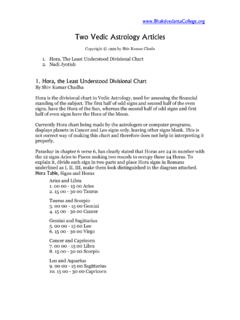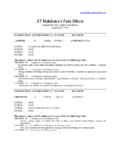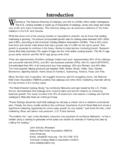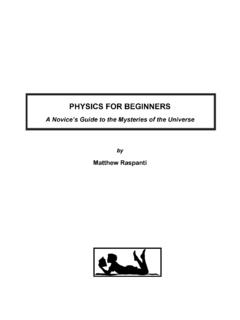Transcription of vedic cosmography astronomy - Bhaktivedanta …
1 vedic cosmography and astronomy by Richard L. Thompson The universe as described in the Fifth Canto of Srimad-Bhagavatam seems strikingly different from the universe of modern astronomy . This book addresses this apparent conflict in detail, and outlines a systematic approach to understanding the Fifth Canto. Topics include the celestial geometry of Bhu- mandala, mystic powers and higher-dimensional realms, vedic mathematical astronomy , the dating of Kali-yuga, space travel, the moon flight, astrophysical anomalies, and much more. The following text is the 1st chapter of this book. Interested readers are directed to purchase the book from the publisher at: ~bvi/. 1. THE ASTRONOMICAL SIDDH NTAS. Since the cosmology of the astronomical siddh ntas is quite similar to traditional Western cosmology, we will begin our discussion of vedic astronomy by briefly describing the contents of these works and their status in the Vai ava tradition.
2 In a number of purports in the Caitanya-carit m ta, r la Prabhup da refers to two of the principal works of this school of astronomy , the S rya-siddh nta and the Siddh nta- iroma i. The most important of these references is the following: These calculations are given in the authentic astronomy book known as the S rya-siddh nta. This book was compiled by the great professor of astronomy and mathematics Bimal Pras d Datta, later known as Bhaktisiddh nta Sarasvat Gosv m , who was our merciful spiritual master. He was honored with the title Siddh nta Sarasvat for writing the S rya-siddh nta, and the title Gosv mi Mah r ja was added when he accepted sanny sa, the renounced order of life [CC AL ]. Here the S rya-siddh nta is clearly endorsed as an authentic astronomical treatise, and it is associated with r la Bhaktisiddh nta Sarasvat h kura. The S rya-siddh nta is an ancient Sanskrit work that, according to the text itself, was spoken by a messenger from the sun-god, S rya, to the famous asura Maya D nava at the end of the last Satya-yuga.
3 It was translated into Bengali by r la Bhaktisiddh nta Sarasvat , who was expert in vedic astronomy and astrology. Some insight into r la Bhaktisiddh nta's connection with vedic astronomy can be found in the bibliography of his writings. There it is stated, In 1897 he opened a Tol named Saraswata Chatuspati in Manicktola Street for teaching Hindu astronomy nicely calculated independently of Greek and other European astronomical findings and calculations. During this time he used to edit two monthly magazines named Jyotirvid and Brihaspati (1896), and he published several authoritative treatises on Hindu astronomy . He was offered a chair in the Calcutta University by Sir Asutosh Mukherjee, which he refused [BS1, pp. 2 3]. These statements indicate that r la Bhaktisiddh nta took considerable interest in vedic astronomy and astrology during the latter part of the nineteenth century, and they suggest that one of his motives for doing this was to establish that the vedic astronomical tradition is independent of Greek and European influence.
4 In addition to his Bengali translation of the S rya-siddh nta, r la Bhaktisiddh nta Sarasvat published the following works in his two magazines: (a) Bengali translation and explanation of Bh skar c rya's Siddh nta-Shiromani Goladhyaya with Basanabhasya, (b) Bengali translation of Ravichandrasayanaspashta, Laghujatak, with annotation of Bhattotpala, (c) Bengali translation of Laghuparashariya, or Ududaya-Pradip, with Bhairava Datta's annotation, (d) Whole of Bhauma-Siddh nta according to western calculation, (e) Whole of rya-Siddh nta by ryabha a, (f). Paramadishwara's Bhatta Dipika-Tika, Dinakaumudi, Chamatkara- Chintamoni, and Jyotish-Tatwa-Samhita [BS1, p. 26]. This list includes a translation of the Siddh nta- iroma i, by the 11th- century astronomer Bh skar c rya, and the rya-siddh nta, by the 6th- century astronomer ryabha a. Bha otpala was a well-known astronomical commentator who lived in the 10th century.
5 The other items in this list also deal with astronomy and astrology, but we do not have more information regarding them. r la Bhaktisiddh nta Sarasvat also published the Bhaktibh vana Pa jik and the r Navadv pa Pa jik (BS2, pp. 56,180). A pa jik is an almanac that includes dates for religious festivals and special days such as Ek da . These dates are traditionally calculated using the rules given in the jyoti a stras. During the time of his active preaching as head of the Gau ya Math, r la Bhaktisiddh nta stopped publishing works dealing specifically with astronomy and astrology. However, as we will note later on, r la Bhaktisiddh nta cites both the S rya-siddh nta and the Siddh nta- iroma i several times in his Anubh ya commentary on the Caitanya- carit m ta. It is clear that in recent centuries the S rya-siddh nta and similar works have played an important role in Indian culture.
6 They have been regularly used for preparing calendars and for performing astrological calculations. In Section we cite evidence from the Bh gavatam suggesting that complex astrological and calendrical calculations were also regularly performed in vedic times. We therefore suggest that similar or identical systems of astronomical calculation must have been known in this period. Here we should discuss a potential misunderstanding. We have stated that Vai avas have traditionally made use of the astronomical siddh ntas and that both r la Prabhup da and r la Bhaktisiddh nta Sarasvat h kura have referred to them. At the same time, we have pointed out that the authors of the astronomical siddh ntas, such as Bh skar c rya, have been unable to accept some of the cosmological statements in the Pur as. How could Vai ava c ryas accept works which criticize the Pur as? We suggest that the astronomical siddh ntas have a different status than transcendental literature such as the r mad-Bh gavatam.
7 They are authentic in the sense that they belong to a genuine vedic astronomical tradition, but they are nonetheless human works that may contain imperfections. Many of these works, such as the Siddh nta- iroma i, were composed in recent centuries and make use of empirical observations. Others, such as the S rya-siddh nta, are attributed to demigods but were transmitted to us by persons who are not spiritually perfect. Thus the S rya-siddh nta was recorded by Maya D nava. r la Prabhup da has said that Maya D nava is always materially happy because he is favored by Lord iva, but he cannot achieve spiritual happiness at any time (SB ). The astronomical siddh ntas constitute a practical division of vedic science, and they have been used as such by Vai avas throughout history. The thesis of this book is that these works are surviving remnants of an earlier astronomical science that was fully compatible with the cosmology of the Pur as, and that was disseminated in human society by demigods and great sages.
8 With the progress of Kali-yuga, this astronomical knowledge was largely lost. In recent centuries the knowledge that survived was reworked by various Indian astronomers and brought up to date by means of empirical observations. Although we do not know anything about the methods of calculation used before the Kali-yuga, they must have had at least the same scope and order of sophistication as the methods presented in the S rya- siddh nta. Otherwise they could not have produced comparable results. In presently available vedic literature, such computational methods are presented only in the astronomical siddh ntas and other jyoti a stras. The Itih sas and Pur as (including the Bh gavatam) do not contain rules for astronomical calculations, and the Ved s contain only the Ved ga-jyoti a, which is a jyoti a stra but is very brief and rudimentary (VJ). The following is a brief summary of the topics covered by the S rya- siddh nta: (1) computation of the mean and true positions of the planets in the sky, (2) determination of latitude and longitude and local celestial coordinates, (3) prediction of full and partial eclipses of the moon and sun, (4) prediction of conjunctions of planets with stars and other planets, (5) calculation of the rising and setting times of planets and stars, (6) calculation of the moon's phases, (7) calculation of the dates of various astrologically significant planetary combinations (such as Vyat p ta), (8) a discussion of cosmography , (9) a discussion of astronomical instruments, and (10) a discussion of kinds of time.
9 We will first discuss the computation of mean and true planetary positions, since it introduces the S rya-siddh nta's basic model of the planets and their motion in space. The Solar System According to the S rya siddh nta The S rya-siddh nta treats the earth as a globe fixed in space, and it describes the seven traditional planets (the sun, the moon, Mars, Mercury, Jupiter, Venus, and Saturn) as moving in orbits around the earth. It also describes the orbit of the planet R hu, but it makes no mention of Uranus, Neptune, and Pluto. The main function of the S rya-siddh nta is to provide rules allowing us to calculate the positions of these planets at any given time. Given a particular date, expressed in days, hours, and minutes since the beginning of Kali-yuga, one can use these rules to compute the direction in the sky in which each of the seven planets will be found at that time.
10 All of the other calculations described above are based on these fundamental rules. The basis for these rules of calculation is a quantitative model of how the planets move in space. This model is very similar to the modern Western model of the solar system. In fact, the only major difference between these two models is that the S rya-siddh nta's is geocentric, whereas the model of the solar system that forms the basis of modern astronomy is heliocentric. To determine the motion of a planet such as Venus using the modern heliocentric system, one must consider two motions: the motion of Venus around the sun and the motion of the earth around the sun. As a crude first approximation, we can take both of these motions to be circular. We can also imagine that the earth is stationary and that Venus is revolving around the sun, which in turn is revolving around the earth.









